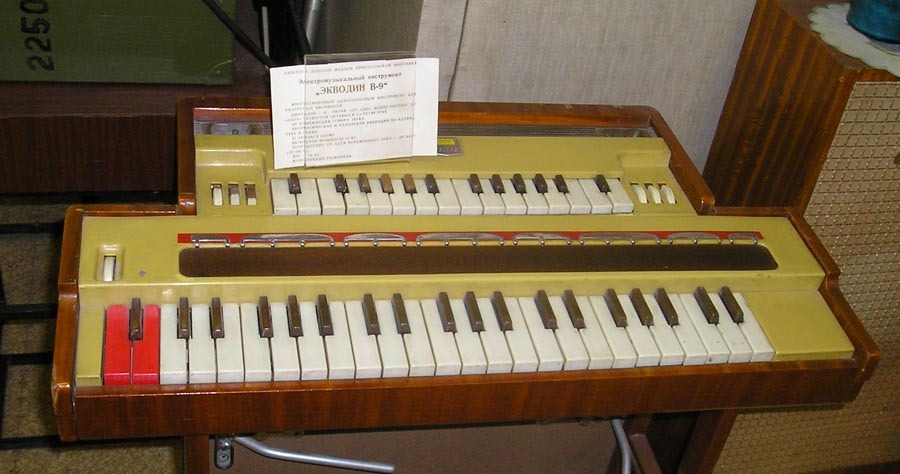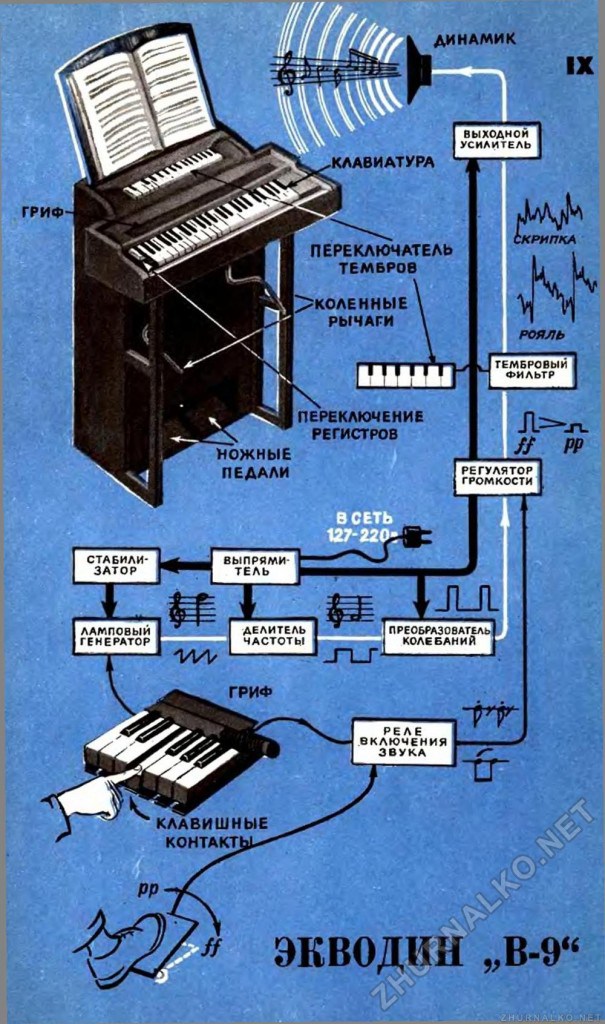Unknown - Ekvodin Demonstration Record [Всесоюзная Студия Грамзаписи, 1960?, EP]
The history of electronic music in the Soviet Union stretches all the way back to the very beginning of the USSR as a state, with the pioneering eerie sounds of Lev Termen's "Терменбокс", or the theremin, as it is better known outside the CIS sphere, invented in 1920 as part of research into sensor equipment during the Russian Civil War. The early years of the Soviet Union were a great time for the development of unique ways of creating music, culminating in instruments that have not been explored since; not just the theremin itself but also the one-of-a-kind pictorial ANS synthesizer, famously used by Eduard Artemyev for otherworldly if not outright creepy soundscapes for movies like Solaris. It is during this time, around 1930, that a then-young Andrey Volodin developed the "Ekvodin".
The Ekvodin
The Ekvodin is almost a historical footnote now, but at the time it was a source of great pride for the Soviet state, eventually being developed into commercial models and winning gold medals at the 1958 World's Fair in Brussels. Reports differ on how successful it was - some sources say only 12 were ever made, while others say it was relatively successful with a large number of models. All I can say for sure is that there were at least four models of Ekvodin (V-4, V-5, V-7, V-8 and V-9), and that the most common model appeared to be the two-octave single- and two-voiced versions, which are similar to the V-9 ("В-9") in structure. While Volodin went on to study psychoacoustics and teach at the Moscow State Conservatory, as well as developing plans for a polyphonic Ekvodin, it was only his first forays into single- and dual-voiced synthesizers that were ever built.

An Ekvodin V-9, likely the model used on this record
The Ekvodin is a truly groundbreaking instrument, with a velocity-sensitive keyboard for vibrato (wiggle the key side to side) and pedals for volume, and generated the sound through a number of configurable pre-set filters and octave dividers that can combine for up to 660 settings. The single-voice version weighs 35kg and the dual-voice (as above) weighs 65kg, making them reasonable to cart around, though still quite heavy. The Ekvodin is advertised as being able to imitate the full range of symphonic instruments, from woodwinds to brass to strings and even some folk instruments like the duduk. This is quite the claim, but as you listen to this demonstration record you can see that, in fact, it does a pretty good job of it. While some instruments sound outright silly, like the balalaika, most of the examples chosen are remarkably convincing, like the violoncello or the bassoon. I find that the Ekvodin has a very wide range of expression and is able to produce all sorts of natural timbres, likely a result of years of tuning and psychoacoustic research from Volodin.

Diagram of the Ekvodin V-9. As you can see, the keyboard sends a signal to be passed through various filters, which is made louder or quieter by pedals under the instrument, and wiggling the keys produces vibrato
The Ekvodin is relatively unknown when mentioned by itself, but it was used extensively by perhaps one of the most well-known musicians of the Soviet Union, Vyacheslav Mescherin. While only recently has his name become more well-known, his music produces almost Pavlov-like reactions for anyone who lived through the 50s and onward in the Soviet Union, as it was absolutely everywhere - conference rooms, the radio, the factory, even the famous cartoon Ну, погоди! had some of its soundtrack composed and performed by Vyacheslav Mescherin's Electromusical Instrument Orchestra - with the Ekvodin leading the melody.
As Mescherin's orchestra demonstrates here, the Ekvodin can even sound like a chicken!
The Record
Which brings us to this record - packaged plain, with no label other than "Informational Record for the Electromusical Instrument Ekvodin", on the All-Union Recording Studio label (Всесоюзная Студия Грамзаписи), which in 1964 became Melodiya's main studio, as part of the new singular record label for the entire Union. This mysterious 10" vinyl disc is as the label describes, a thorough walkthrough of the Ekvodin's capabilities demonstrated by skilled and uncredited performers, both the single- and dual-voice types.
Track breakdown
Side A starts off with a lovely waltz by Viktor Sams - who I have been able to find no information about; please drop me a line if you know anything! - before transitioning into a whirlwind tour of how the Ekvodin can produce the sounds of the symphony: the bows, the woodwinds, brass, and a remarkably good slide guitar, most done with piano accompaniment. In most of these cases the Ekvodin performs admirably, and you can see just how amazing the instrument really is, to have been designed so long ago - and before transistors! - and yet produce such wonderful natural sounds. Then, the performers proceed to demonstrate various folk instruments. The balalaika is a little silly, but the duduk is rather close to its natural, haunting sound. Side A closes out with a demonstration of vocal timbre (which just sounds like a more full-bodied theremin), and plays Ravel's Bolero to show the two-octave range of the instrument, before closing out with bells, which sound about how you know bells would sound over AM radio. In other words - Ekvodin broadcast before FM would certainly fool many listeners!
Side B shows the instrument on its own, as an Ekvodin quartet performs songs from the ancient and traditional (Кукует кукушечка ) to modern Soviet compositions (Полюшко-Поле). These pieces really show off the vast timbral range of the Ekvodin, and I think it makes you appreciate it all the more. The peak of the performances is Flight of the Bumblebee, showing off the responsiveness of the keyboard, in particular the vibrato function - and the virtuosity of the Ekvodin player since, as you know, the keys need to be wiggled for vibrato!
Overall, the record has made me not only appreciate the amazing work done by Andrey Volodin over 80 years ago (!) in an age where we still struggle with synthesized instruments sounding "fake", but also to find the Ekvodin in Mescherin's recordings. I always saw the Ekvodin in the performances his orchestra recorded, looking like an unreasonably tall toy piano, but now knowing the full range of its sound, you really become able to pick it out anywhere. Who knows - perhaps after listening to this you'll find it somewhere in an old Soviet record yourself!
Track List and Rip
The notion of "tracks" is a little misleading as this record is one long, continuous groove on each side. That said, there are clear subdivisions and sections to each side, and I have listed below what I understand are the divisions. I am still getting the hang of Russian orthography, so please correct me if I've mis-spelled anything!
Side A:
A1. Introduction - Waltz, composed by Viktor Sams. Two Ekvodins (one single-voiced, one dual-voiced), accompanied by piano.
A2. Basic explanation of Ekvodin and timbre variation. (Note, the rest of side A is single two-voice Ekvodin either solo or accompanied by piano)
A3. Demonstration of "violoncello" timbre.
A4. Interpretation of one of Dvořák's dances (narrator does not specify further) by two-voiced Ekvodin.
A5. Demonstration of "clarinet" timbre.
A6. Demonstration of "oboe" timbre.
A7. Demonstration of "bassoon" timbre.
A8. Demonstration of "piccolo" timbre (duet between Ekvodins).
A9. Demonstration of "double bassoon" timbre.
A10. Demonstration of "trumpet" timbre.
A11. Demonstration of "muted trumpet" timbre.
A12. Demonstration of "french horn" timbre.
A13. Demonstration of various strings.
A14. Demonstration of "guitar" timbre. (Sounds like a slide guitar, a pretty accurate one at that!)
A15. Demonstration of "duduk" timbre. (more accurate than you'd think)
A16. Demonstration of "zurna" timbre.
A17. Demonstration of "balalaika" timbre.
A18. Demonstration of "vocal" timbre.
A19. Ravel's "Bolero", used to demonstrate two-octave range of Ekvodin.
A20. Demonstration of "bell" timbre.
Side B:
B1. Russian folk song, Кукует кукушечка.
B2-B3: Suite, composer Mikhail Kadomtsev (I think this might be Игорь Михайлович Кадомцев, but the dates don't work out. If anyone knows who this is, let me know).
B2. Prelude.
B3. Toccata.
B4. Oriental Melody, fragment. Author unknown, sounds like "Kuiy".
B5. Daquin, Le Coucou (Кукушка)
B6. Anatoly Lyadov - Musical Snuffbox (Музыкальная табакерка), fragment.
B7. Ilya Sergeevich Glazunov - Spanish Serenade (Илья Серге́евич Глазунов - Испанская серенада), fragment
B8. Rimsky-Korsakoff - Flight of the Bumblebee (Ри́мский-Ко́рсаков - Полет Шмеля)
B9. Lev Knipper - Oh Fields, My Fields (Лев Книпперь - Полюшко-Поле) (Translation per how I've seen releases of the Alexandrov Ensemble handle the translation)
Get the record HERE